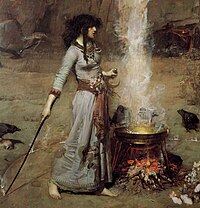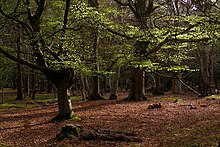Coven
This article needs additional citations for verification. (October 2018) |
| Part of a series on |
| Witchcraft |
|---|
 |
A coven (/kʌvən/) is a group or gathering of witches. The word "coven" (from Anglo-Norman covent, cuvent, from Old French covent, from Latin conventum = convention) remained largely unused in English until 1921 when Margaret Murray promoted the idea that all witches across Europe met in groups of thirteen which they called "covens".[1]
Modern paganism
| Part of a series on |
| Wicca |
|---|
 |

In
The number of people involved may vary. Although some consider thirteen to be ideal (probably in deference to
Wiccan covens are usually jointly led by a
Online covens
With the rise of the Internet as a platform for collaborative discussion and media dissemination, it became popular for adherents and practitioners of Wicca to establish "online covens" which remotely teach tradition-specific crafts to students in a similar method of education as non-religious
However, because of potentially-unwieldy membership sizes,[clarification needed] many online covens limit their memberships to anywhere between 10 and 100 students. The CFFN, in particular, tried[when?] to devolve its structure into a system of sub-coven clans (which governed their own application processes), a system which ended in 2003 due to fears by the CFFN leadership that the clans were becoming communities in their own right.[citation needed]
Other contemporary forms
The Urban Coven is a group founded on Facebook by Becca Gordon for women in Los Angeles to gather, hike, and howl at the Moon. It meets monthly and is estimated to have almost 3,500 members. A January 2016 gathering at Griffith Park drew nearly 1,000 women, and was described as follows:
A lot of the women ... were there in groups — mothers and daughters, friends, colleagues. Some arrived solo and struck up conversations with other women or hiked in solitude.[9]
In popular culture
In popular culture, a coven is a group or gathering of witches who work spells in tandem. Such imagery can be traced back to
Orgiastic meetings of witches are depicted in the
Films featuring covens include Rosemary's Baby (1968), Crowhaven Farm (1970), Suspiria (1977) and its 2018 remake, The Witches of Eastwick (1987), Four Rooms (1995), The Craft (1996), Coven (1997), Underworld (2003), Underworld: Evolution (2006), The Covenant (2006), Paranormal Activity 3 (2011), The Witch (2015) and Hereditary (2018).[citation needed]
In television, covens have been portrayed in the U.S. in supernatural dramas such as Charmed, Witches of East End, The Vampire Diaries, The Originals, The Secret Circle, True Blood, Once Upon a Time and Chilling Adventures of Sabrina. The third season of American Horror Story is entitled Coven, and focuses on witches. The animated series The Owl House (2020–2023) also focuses on witches, and interprets covens as required organizations of witches with specialized magic.[citation needed]
In vampire novels such as The Vampire Chronicles by Anne Rice and the Twilight series by Stephenie Meyer, covens are families or unrelated groups of vampires who live together.[citation needed]
See also
References
- ^ Murray, Margaret (1921). The Witch Cult in Western Europe: A Study in Anthropology.
- ISBN 978-0-7387-6098-8.
- ISBN 978-1-56718-018-3.
- ISBN 978-0-7387-0082-3.
- ^ K, Amber (2002). Coven Craft: Witchcraft for Three or More. Llewellyn Publications.
- ISBN 978-1-57607-134-2.
- ISBN 9781118070017.
- ^ "Coven of the Far Flung Net". 2006-07-18. Archived from the original on 2006-07-18. Retrieved 2022-12-14.
- ^ Blumberg, Antonia (25 January 2016). "This Is What An 'Urban Coven' Looks Like". Huffington Post. Retrieved 23 March 2018.
Bibliography
- Margot Adler (2006) Drawing Down the Moon. Penguin Books.
- Miriam Simos (1999) The Spiral Dance. San Francisco: Harper.
- Janet and Stuart Farrar (1996) A Witches' Bible: The Complete Witches Handbook. Phoenix Publishing.
